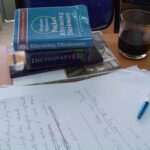The sestina is a very complicated form of poetry, and writing one requires great mental discipline. While you don’t have to worry about maintaining a set rhyme scheme or meter, you do have to meet a considerable number of other requirements, including a set number of stanzas, a specific number of lines per stanza, and a precise placement of recurring words.
What’s So Complicated About the Sestina?
A sestina has a total of 39 lines divided into seven stanzas. The first six stanzas have six lines each, but the seventh, a tercet, has only three. These particular requirements are not the true test of a sestina, however. The real challenge comes with the rules for repetition. Each of the six lines of the first six stanzas must end with the same words, but these words appear in a different order in each stanza. Still doesn’t sound challenging enough? The order of those words is precisely prescribed, and you have to throw those words into the final tercet as well, but spread out two apiece between the three lines.
Confused by this explanation? To give you a better idea of what writing a sestina entails, the sestina form is outlined below. The letters A through F each represent a final word. There are other variations on the form, but this is the most common.
Template for the Sestina Form
Stanza 1 Line 1 — …….A
Stanza 1 Line 2 — …….B
Stanza 1 Line 3 — …….C
Stanza 1 Line 4 — …….D
Stanza 1 Line 5 — …….E
Stanza 1 Line 6 — …….F
Stanza 2 Line 1 — …….F
Stanza 2 Line 2 — …….A
Stanza 2 Line 3 — …….E
Stanza 2 Line 4 — …….D
Stanza 2 Line 5 — …….B
Stanza 2 Line 6 — …….C
Stanza 3 Line 1 — …….C
Stanza 3 Line 2 — …….F
Stanza 3 Line 3 — …….D
Stanza 3 Line 4 — …….A
Stanza 3 Line 5 — …….B
Stanza 3 Line 6 — …….E
Stanza 4 Line 1 — …….E
Stanza 4 Line 2 — …….C
Stanza 4 Line 3 — …….B
Stanza 4 Line 4 — …….F
Stanza 4 Line 5 — …….A
Stanza 4 Line 6 — …….D
Stanza 5 Line 1 — …….D
Stanza 5 Line 2 — …….E
Stanza 5 Line 3 — …….A
Stanza 5 Line 4 — …….C
Stanza 5 Line 5 — …….F
Stanza 5 Line 6 — …….B
Stanza 6 Line 1 — …….B
Stanza 6 Line 2 — …….D
Stanza 6 Line 3 — …….F
Stanza 6 Line 4 — …….E
Stanza 6 Line 5 — …….C
Stanza 6 Line 6 — …….A
Stanza 7 Line 1 — …….F — . B
Stanza 7 Line 2 — …….A — .D
Stanza 7 Line 3 — …….C — .E
Four Steps to Creating Your Sestina
So how do you write a sestina of your own? Try this exercise:
Step 1.
Choose the six words you plan to repeat. Don’t make them too obscure, or you won’t be able to repeat them easily. Don’t choose a preposition, of course, because we all know never to end a sentence with a preposition. Words that can double as two different parts of speech (such as rose, which can be a noun or a verb) might give you greater flexibility. if you don’t know where to start, do what I did when I wrote my first sestina: open a dictionary, flip to a random page, and let your finger fall where it will. Don’t like the word you discover that way? Simply repeat the exercise until you find six words you like. Assign each word a letter A, B, C, D, E, or F.
Step 2.
Cut and paste the sestina template offered in this article.
Step 3.
Place the six words you have chosen in the place holders where it says A, B, C, D, E, and F.
Step 4.
Fill in the rest of the poem as best you can. If you’re struggling, consider changing the tense of one of your words (if it’s a verb), but be sure to change it throughout the poem. Remember, you can run your sentences from one line of poetry to the next; not every line has to end with a period or a comma. Running on your sentences will help you when it comes to fitting in those repeated words.
Congratulations, you’ve written a sestina! If you ‘d like to see an example of a sestina before you tackle one of your own, feel free to look at mine. In fact, I did this exercise using these very steps to write my first sestina. Although I have attempted many poetry forms in the past, and have even published my poetry in a variety of literary magazines, I had never tackled the sestina. Using the four steps outlined above, I produced a sestina that you can read by clicking on the title here: “Unmasked.”






